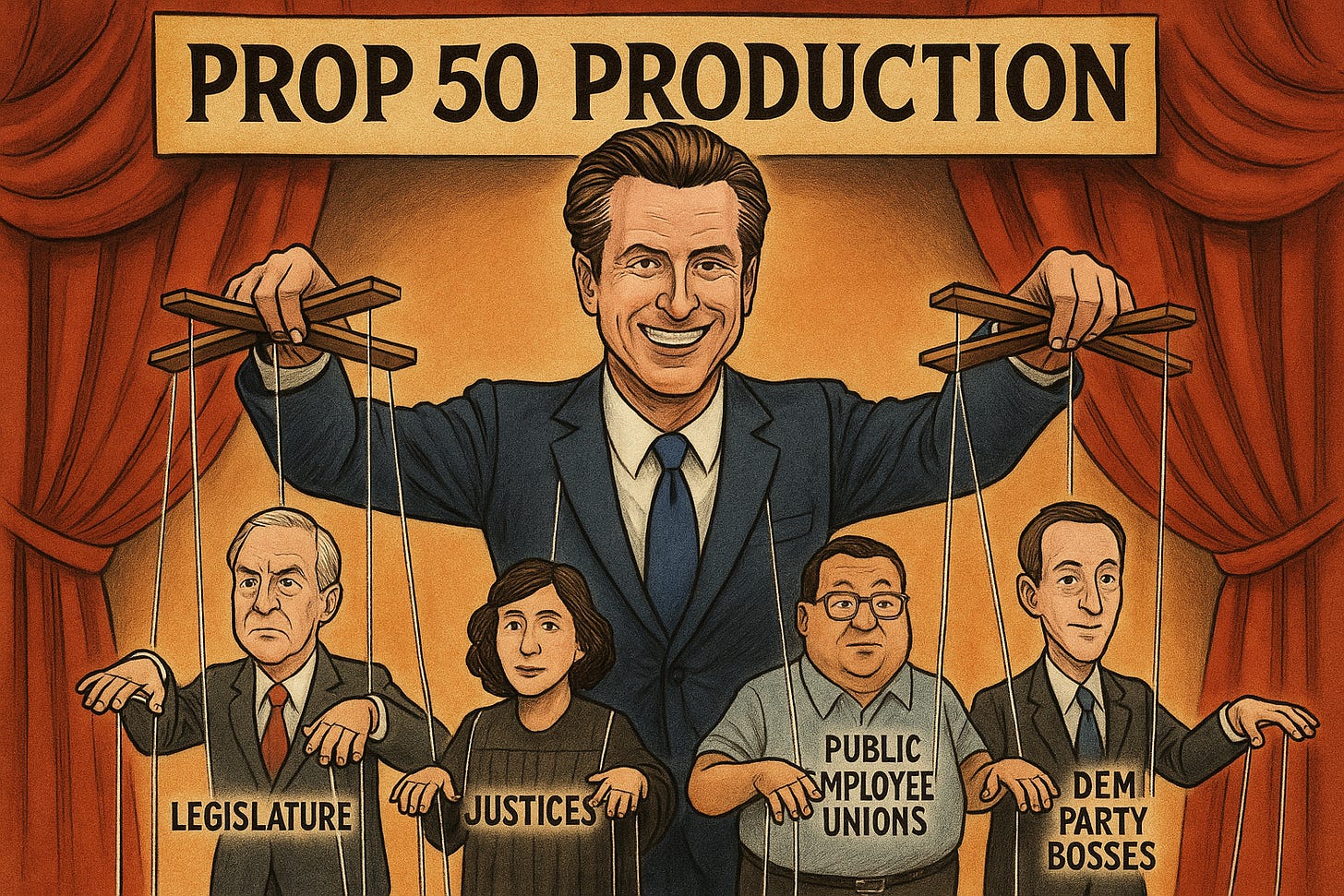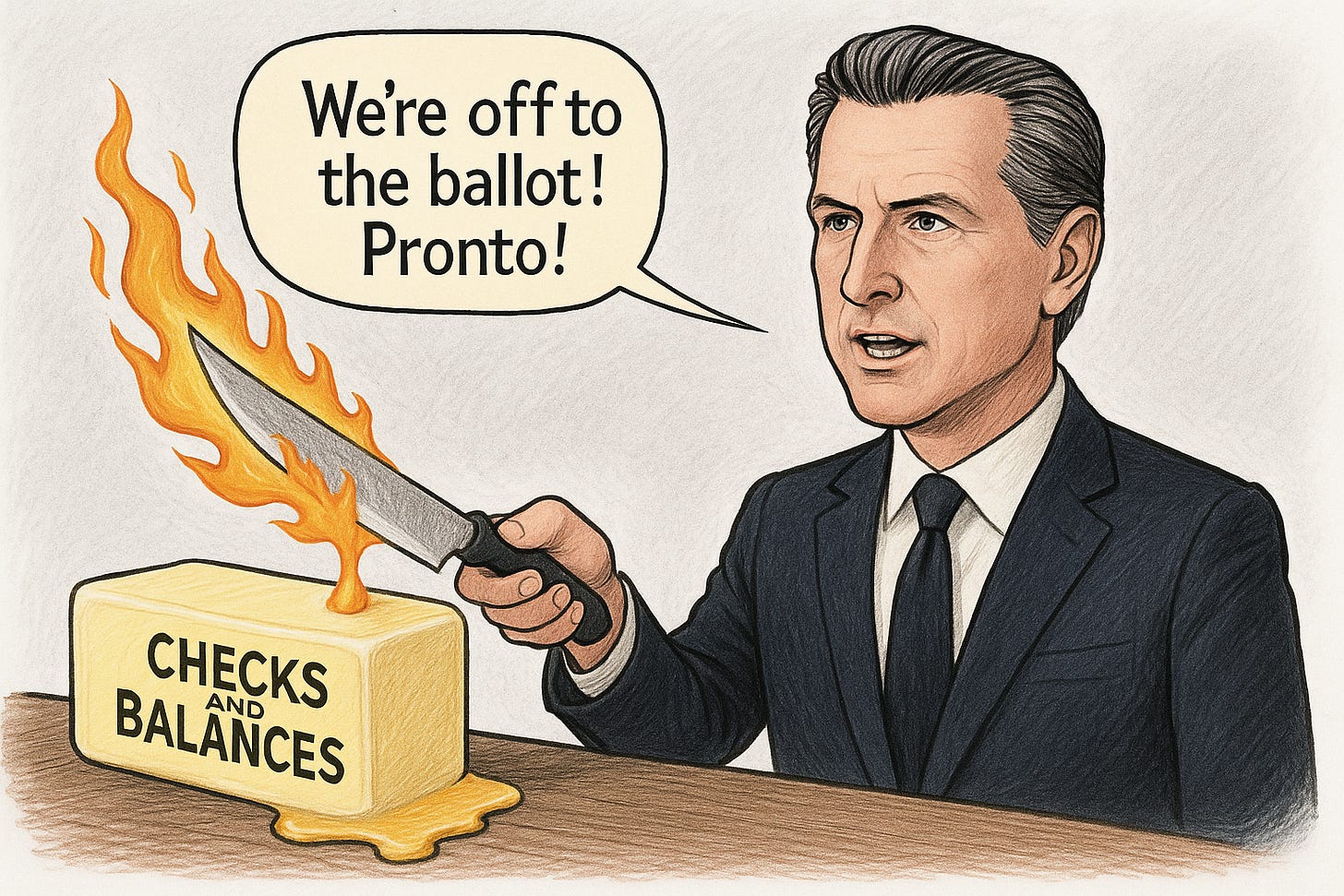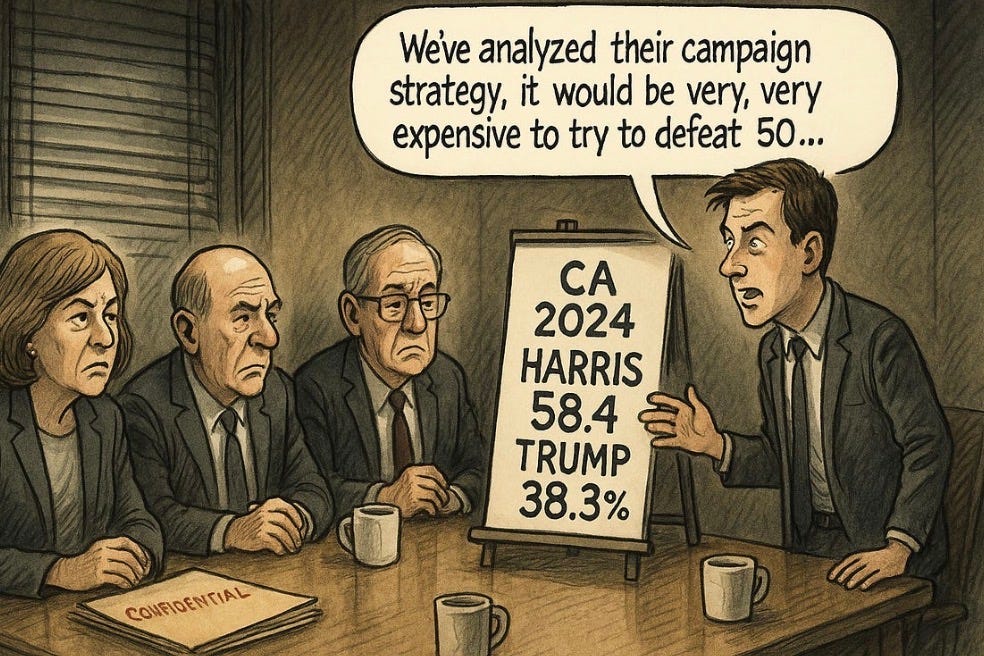Power Play: Three Months From Threat To New Maps, Newsom Poised To Boost Presidential Advance
Three months after pledging to counter GOP gerrymanders, Gavin Newsom’s $300 million special election is poised to redraw California’s map and build his 2028 war chest.
Did someone forward this to you? Grab a free subscription now, or if you want to unlock 40% of our content, consider our paid tier to get it all!
The Throw-Down to Trump
A little less than three months ago, Governor Gavin Newsom took to X to make this statement to President Trump:
Proposition 50 redraws California’s congressional maps in a partisan gerrymander that shifts five seats from red to blue, and locks down a group of competitive districts currently held by Democrats
The Blitzkrieg
To give Newsom some deserved credit — in the same way you might give the Germans “credit” for the infamous Blitzkrieg (“lightning war”) attack on France during WWII — the governor took rhetoric to action quickly. While maintaining his high-profile trolling of the president, he brought together Democratic leaders across the state and implemented an audacious plan to call a special election. Ballots were mailed on October 6, and the election ends tomorrow. Just wow.
Cutting Butter With A Hot Knife
Democrats control every facet of California state government - executive, legislative, and judicial - which means there was nothing to stop this politically brazen gerrymandering scheme. All Newsom needed to do was ensure that the state’s massive public-employee and trade unions were on his side — no complex task.
With rules easily waived and the California Supreme Court essentially looking the other way, there were no guardrails left. The special election’s nearly $300 million price tag was no obstacle. Whipping up the Democratic supermajorities in the legislature was easy, especially after the new maps conveniently created safe Democratic House seats with no incumbents — right where the Senate president and Assembly speaker might run.
Rallying Around The “Anti-Trump” Flag
It turns out that Democrats (and a good number of independents) really do not like Donald Trump. Who knew? From that first October 11 post on X, this was about sticking the president with a hot poker. That theme united Democratic leaders in passing new maps and presenting them to voters — and it have became a rallying cry for Democratic voters across California.
If you’re in one of those Democratic households, this special election generated more targeted advertising aimed at you than last year’s presidential race. Talking to more than ten million registered Democrats costs money — a lot of it. All that outrage needed fuel, and money followed the message.
The Newsom Fundraising Machine
In just ten weeks, the campaign raised $114 million. More than 100,000 people donated to Gavin Newsom’s Prop 50 campaign who had never given to him before. Those new donors made up 93 percent of all individuals backing his committee — a staggering 107,000 identifiable donors in total, more than in his 2018, 2021 (recall), and 2022 campaigns combined.
Tens of millions also came from California’s public-employee and trade unions, as well as from special interests that do a significant amount of business with the state — groups such as the California Teachers Association, SEIU, and Hollywood film companies and streaming services (think Reed Hastings at Netflix) who benefit from generous state tax credits.
Timing, as they say, is everything, and Prop. 50 — framed as a hard slap at Trump — became a kind of national GoFundMe for the Democratic Left. By the time ballots arrived, Newsom had tapped into a small-donor ecosystem most governors could only dream of.
The Tactical Retreat of Republican Big Money
When this idea first surfaced, it wasn’t taken seriously. One almost sensed Newsom wondering, “Can I really pull this off?”
Charles Munger Jr. was the first to oppose it, pledging over $30 million early. Wealth from inheritance (his father was Warren Buffet’s business partner), Munger financed the statewide campaigns back in 2008 and 2010 that created the independent redistricting commission and then applied it to Congressional lines. Former Speaker Kevin McCarthy then announced he would spearhead a more partisan effort to raise $100 million to defeat the measure. In the end, McCarthy-aligned committees raised about $11 million, and the broader opposition — including Munger and GOP allies — has totaled roughly $43.7 million, compared to $114 million for Newsom’s side. Most of this was spent early, in advance of ballots being in voters’ hands, in anticipation of larger funds coming in.
And this seems to be a good time to mention that the Terminator turned out to be the SeeYouLater” with Arnold Schwarzenegger, who did come out against Prop. 50, declining to officially engage in a meaningful way.
In the end, national Republicans clearly concluded California’s political math was not winnable. Saving that money for the competitive races on the national map in 2026 seemed the safer play for them, and Newsom was left with an open field.
A Referendum on Trump
Last November, the final tally in California’s presidential election was 58.5 percent for Kamala Harris and about 38.3 percent for Donald Trump. With Newsom’s framing of Prop. 50 as a referendum on Trump, the final numbers may look much the same.
The Public Policy Institute of California’s final pre-election poll pegged the likely “Yes” vote at 60 percent and the “No” vote at 38 percent. Redistricting is an obscure, procedural issue. By making it all about Trump, Newsom turned an abstract process into a moral statement. The massive funding gap only made his job easier: the other side couldn’t compete for attention.
So, Does It Matter?
Tomorrow the action ends — and barring an upset, Prop. 50 will pass. Then a few things happen all at once.
First, opponents will file lawsuits in federal court, throwing every argument they can — constitutional, procedural, and political — to see what sticks. The biggest question: will a judge issue an injunction blocking implementation? If not, California’s 2026 elections will proceed on new maps.
Second, the Secretary of State and 58 county registrars will scramble to adjust boundaries, update databases, and prepare for candidate filing. The most notable collision will be in the new CA-40, where Republicans Ken Calvert and Young Kim are drawn into the same district. Elsewhere, some Republicans in Congress will be looking for new jobs, and some Democrats will be looking to replace them.
Finally, Gavin Newsom will take a victory lap. California’s de facto president-in-waiting will flaunt his success, raise money to help in other mid-decade redistricting battles, and continue to make his case that he is the right progressive to win an election to the White House in 2028.






